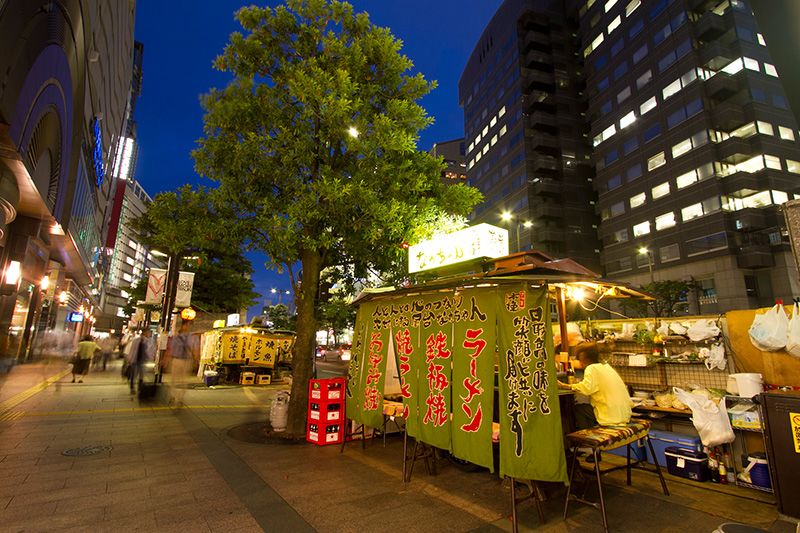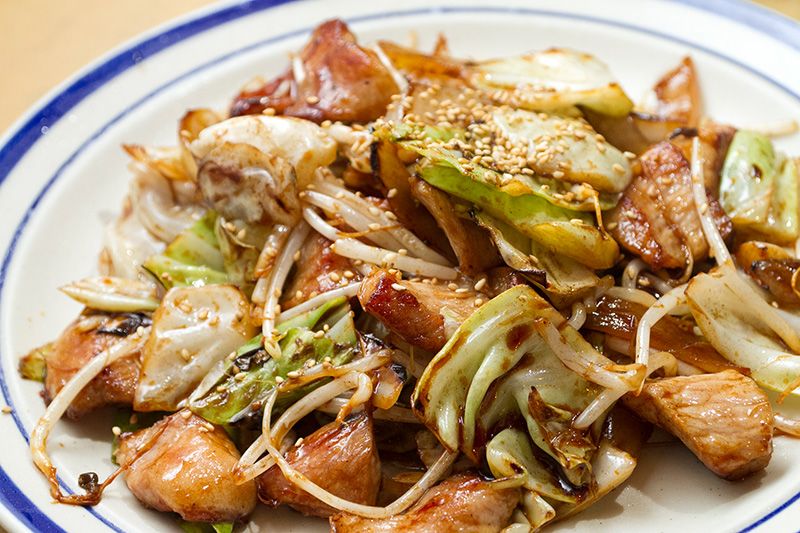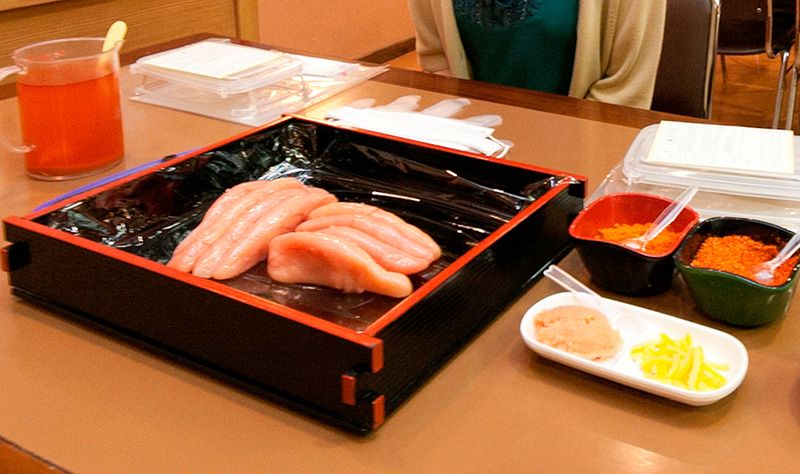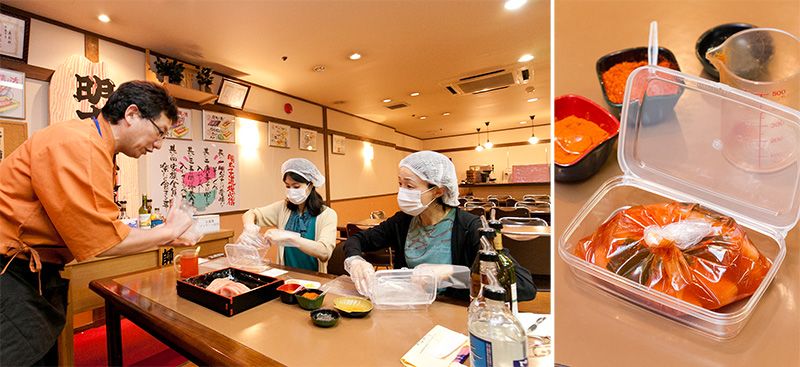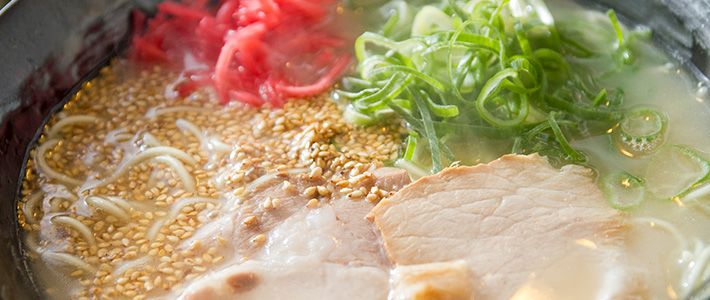
Matsuri Days (3): A Guide to Hakata and the Yamakasa Festival
Eating with the Locals in Hakata
Guideto Japan
Society Culture Lifestyle- English
- 日本語
- 简体字
- 繁體字
- Français
- Español
- العربية
- Русский
Traditional Food Stalls: Great Food and Great People
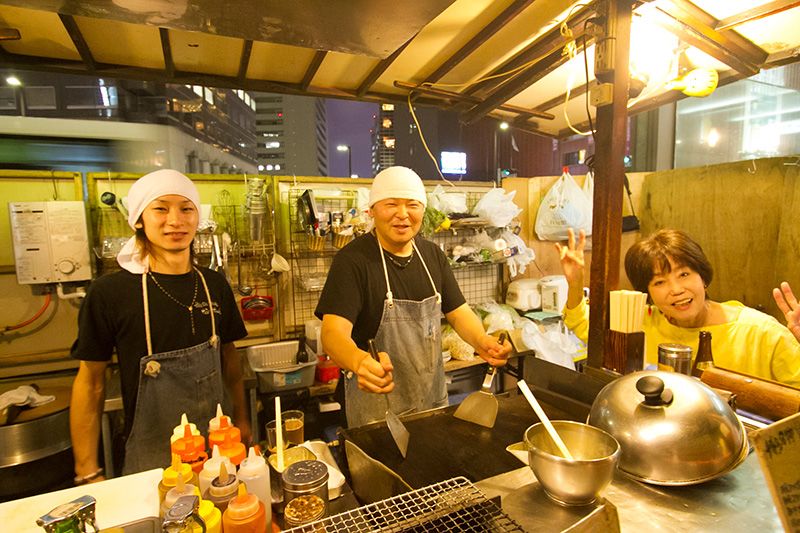 “Nakachan,” one of Hakata’s many lively street stalls. (Located at Mitsukoshimae on the Watanabe-dōri in Fukuoka-shi.) The owner, Nakagawa Yōichi, is in the center.
“Nakachan,” one of Hakata’s many lively street stalls. (Located at Mitsukoshimae on the Watanabe-dōri in Fukuoka-shi.) The owner, Nakagawa Yōichi, is in the center.
The Chance to Make Your Own
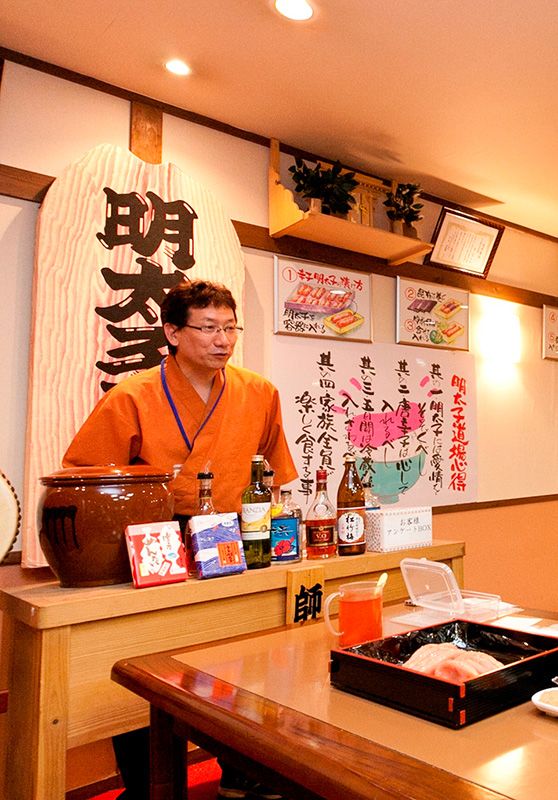 Tomonō Atsushi, instructor at the Karashi Mentaiko Dōjō (Fukuoka Kankō Kaikan Hakata, Hakata-ku, Fukuoka-shi).
Tomonō Atsushi, instructor at the Karashi Mentaiko Dōjō (Fukuoka Kankō Kaikan Hakata, Hakata-ku, Fukuoka-shi).
Motsunabe: Hakata’s Filling and Nutritious Hot Pot
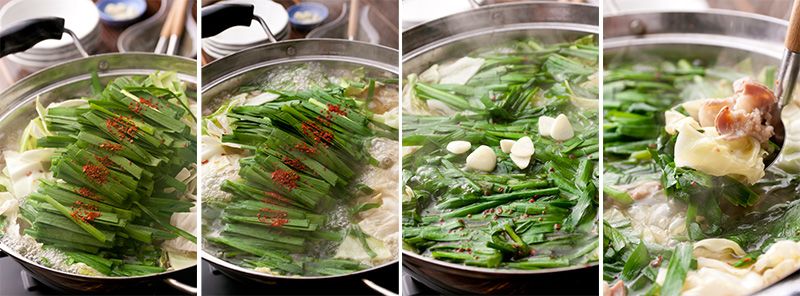 The “motsunabe” is brought to the table overflowing with fresh vegetables that gradually sink into the soup as the stew cooks in front of you.
The “motsunabe” is brought to the table overflowing with fresh vegetables that gradually sink into the soup as the stew cooks in front of you.
I asked my colleague if there was anything she couldn’t eat. I needn’t have worried. “The Chinese eat anything,” she replied with gusto. “If it flies in the sky, and it’s not a plane, we eat it. If it’s in the sea, and it’s not a ship, we eat it!” I suggested motsunabe, a popular stew made in a hot pot (nabe) filled with soup, vegetables, and pork or beef offal (motsu). As one of the best-known local dishes, it seemed a promising choice—especially as even my omnivorous colleague admitted she hadn’t tried it before. We visited a restaurant called Hakata Akachokobe, diagonally across from the Kushida Shrine, one of the most important Shintō shrines in Hakata. The pot that was set down in front of us was brimming over with cabbage and chives. A small burner was lit underneath the pot, and we watched as the vegetables slid into the bubbling broth before our eyes. A sprinkling of garlic on the top, and the soup was ready to taste. We spooned a helping onto our plates, and the tender offal rose at last to the surface. So, I asked, how does it taste? “Delicious. And much lighter than I expected.”
Eating on the Streets of Hakata
The following is an account written by one of our Chinese translators.
It was raining, so we didn’t want to linger outside any longer than necessary. We hurried through the rain and ducked under the curtains into the comfort of one of the covered stalls that lined the street. Three or four salarymen in suits were already inside, drinking and chatting after a day in the office. The owner was busy pouring drinks and preparing food, trading jokes and banter with his customers as he worked. It was a relaxed and friendly atmosphere.
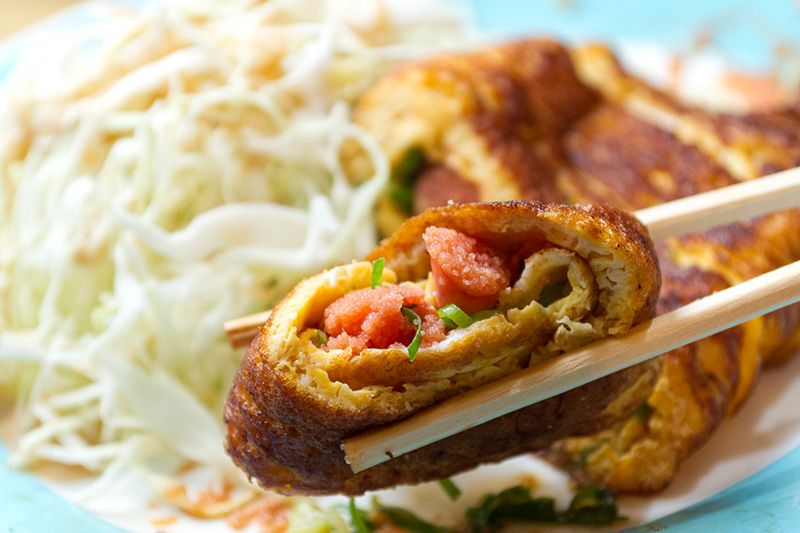 An omelet filled with “karashi mentaiko.”
An omelet filled with “karashi mentaiko.”
We sat down near the entrance and ordered food and drinks. Several more people entered, greeting the owner and the other customers with the air of regulars. Although there were only 10 of us, we were already pressed for space around the U-shaped counter. Unused to the atmosphere, and suddenly finding myself surrounded by so many strangers, I started to feel nervous. Uncertain what to do, I concentrated on my food in silence.
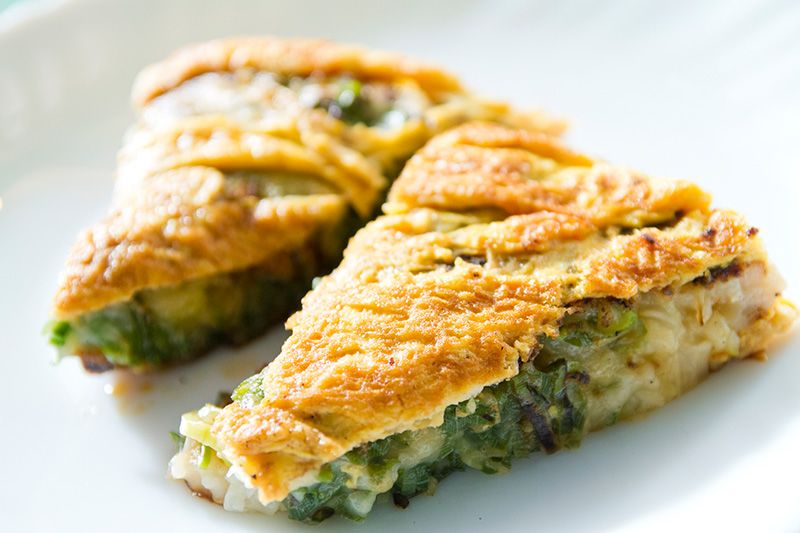 The owner says that there are over 100 items on the menu, many of them the result of customers’ requests.
The owner says that there are over 100 items on the menu, many of them the result of customers’ requests.
The man sitting opposite me suddenly cut into his freshly made mentaiko omelet with his chopsticks and handed half of it to me. “Here, try this,” he said. My first instinct was to refuse, but the owner explained that this was normal procedure. “When we eat out at the stalls, it’s normal for us to share with each other,” he said. I accepted and ate the omelet. It was delicious.
What happened next was even more unexpected. I had noticed that the elderly man sitting next to me had been scribbling intently for some time. Presently he finished and handed me a piece of paper. “Could you tell me if I’ve written this correctly?”
Talking About Li Bai in Hakata
Written on the piece of paper was a famous poem, “Departing from Baidi in the Morning,” by the Tang poet Li Bai. It was written perfectly, without a single mistake. Another young man sitting by us was as impressed as I was. “How come you know something like that?” he asked. With a hint of pride, the older man replied, “In the old days, everyone used to study Chinese poetry. It was the sign of an educated man, you know.” Suddenly, everyone around the counter was joining in a lively discussion about the influence of Chinese on Japanese, quoting the various proverbs, poems, and historical figures they knew. Before I knew it, my nervousness had disappeared and more than an hour had flashed by.
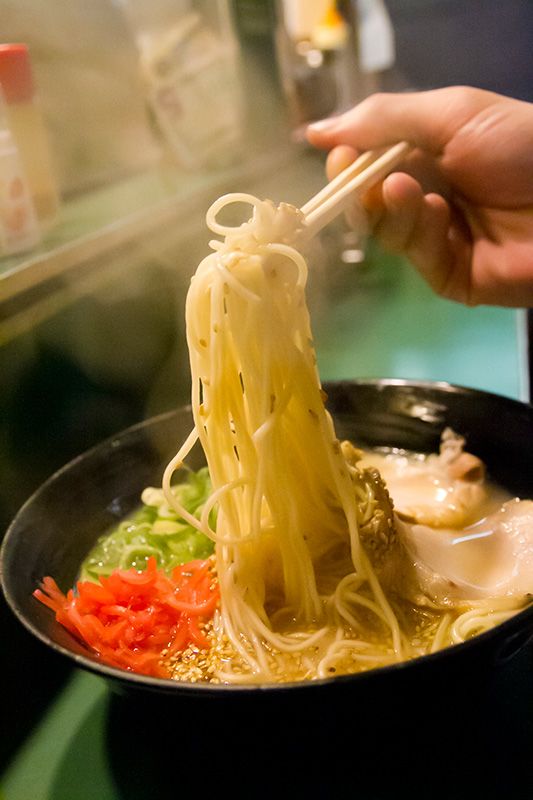 Rāmen noodles: One of the indispensable classics of Japanese street stall menus.
Rāmen noodles: One of the indispensable classics of Japanese street stall menus.
Although our experience of Hakata’s street food culture was very brief, it was enough to give me a sense of what makes this style of eating and drinking so attractive. Street stalls like this one are a treasured part of local culture. Night after night, they are bustling with life and activity. People come not just for the food, but for an experience that is difficult to find elsewhere. There are no barriers here: The moment you sit down, you are part of the crowd, chatting and mixing on easy terms with the people around you, whether you are one of the regulars or a complete stranger. Good food, good drink, and good conversation—what better way could there be to relax after a long day at work than an hour or two in one of Hakata’s local street food stalls? They may be small, but they are filled with warmth and humor.
Making Our Own Karashi Mentaiko
The following is an account written by one of our Chinese translators.
The workshop leader, Tomonō Atsushi, began by talking us through the history of karashi mentaiko and how it is made. Originally a Korean dish, karashi mentaiko entered Japan through Hakata and is now popular all over the country.
Before we started, Tomonō-san provided us with gloves, masks, and caps. We started by putting the fish roe into a special container and then added chili pepper to taste, along with either kombu (dried kelp) or yuzu (a citrus fruit) as a topping. Next, we had to choose an alcoholic spirit to add to the mentaiko as a flavor enhancer and preserving agent. We could chose from white wine, brandy, sake, shōchū (a distilled drink made from barley, sweet potatoes, or other ingredients), and awamori (a distilled spirit produced in Okinawa from long-grained rice). I opted for a generous dash of chili pepper plus yuzu and white wine. Tomonō-san told us that all these types of alcohol are commonly used in commercially produced karashi mentaiko, with the exception of brandy. This was enough to persuade my coworker to choose the brandy. She knew the opportunity would not come again!
The Secret Sauce
The last thing to be added was a red sauce for flavoring. I was curious to know what goes into the sauce, but Tomonō-san shook his head. “Trade secret,” he said with a smile. “Even I don’t know what’s in it!” Once you’ve decided your personal recipe, the shop will keep your details on record for any follow-up orders.
We filled in a label with the date and the details of the ingredients we had chosen. Then the container was sealed tight and our work was over. In total, the whole process took around 40 minutes. Finally, we were issued with souvenir certificates with our names on them, and told that our creations would be ready for us to enjoy in five days. I could hardly wait.
(Photographs by Kusano Seiichirō)
Hakata Fukuoka Nakachan Nakagawa Yoichi karashi mentaiko Karashi Mentaiko Dojo Tomono Atsushi Hakata Akachokobe Kusano Seiichiro hot pot nabe motsunabe roe
